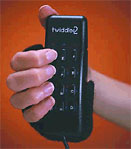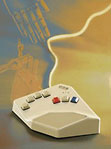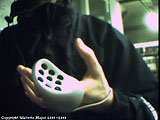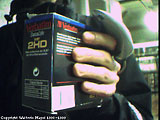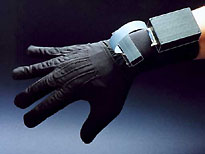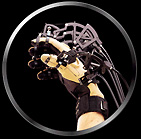 Today's
Cyborgs
Today's
Cyborgs
Ten percent of our population is already technically cyborg, with machine constructs completely embedded in the organic mechanism: prosthetic limbs, pacemakers, these are machine put inside the body, these are cyborgs. But there are countless others in our culture, almost everyone, that are engaged in cybernetic interactions with machine interfaces. Sometimes these are referred to as metaphorical cyborgs. The distinctions are becoming hazy, ambiguous. No longer can man & machine be viewed as an inexorable dichotomy.
So when you sit down at your keyboard, and you're tapping at the keys, searching for information on the internet, that's cybernetic integration. It's not a particularly comfortable or efficient means of communicating with the digital realm. As a matter of fact, such common configurations (sitting in front of the computer, hands on keyboard) are actually disabling to the human body: how many people do you know who wear wrist braces because using a keyboard has caused carpel tunnel syndrome? We've been adapting our bodies to an arbitrary and crippling configuration in order to interface with our machines, and it is critical to change this mode of construction, to learn to adapt the machines to our bodies and not our bodies to the machines.
Current attempts to address these problems include ergonomic
input devices such as chording keyboards:
Data gloves are another attempt to integrate the machines with our bodies in a more comfortable way:
 Other
cyborg devices just coming into fashion are miniaturized wearable computers,
units that strap to your body so you can take your computing with you
in a seamless and transparent way. All of these attempts to correct the
problems of the current standard machine interface are aimed at a deeper
integration of the interface into our bodies-- and this process will likely
accelerate in the coming years. The boundaries between body and tool will
blur as we continue to improve and extend our capabilities with technology.
This advanced integration raises questions and concerns. Does anyone here
believe that there should be limits, boundaries that should not be crossed?
What are they? Is there any place you personally wouldn't go? Would you
put a machine under your skin? For what purpose? Is there a difference
between cybernetics to save and normalize lives vs. to enhance and augment
bodies? It's possible that cybernetics could produce superhumans, and
who will have access to such technologies? These are issues to think about,
and some of the issues we hope to address in our research and performances.
Other
cyborg devices just coming into fashion are miniaturized wearable computers,
units that strap to your body so you can take your computing with you
in a seamless and transparent way. All of these attempts to correct the
problems of the current standard machine interface are aimed at a deeper
integration of the interface into our bodies-- and this process will likely
accelerate in the coming years. The boundaries between body and tool will
blur as we continue to improve and extend our capabilities with technology.
This advanced integration raises questions and concerns. Does anyone here
believe that there should be limits, boundaries that should not be crossed?
What are they? Is there any place you personally wouldn't go? Would you
put a machine under your skin? For what purpose? Is there a difference
between cybernetics to save and normalize lives vs. to enhance and augment
bodies? It's possible that cybernetics could produce superhumans, and
who will have access to such technologies? These are issues to think about,
and some of the issues we hope to address in our research and performances.
The Psymbiote Develops |
